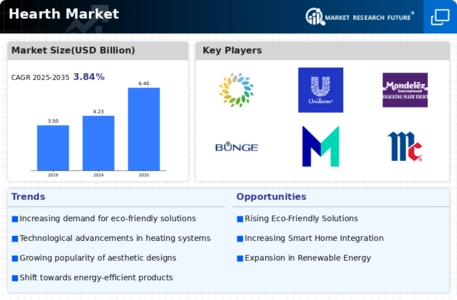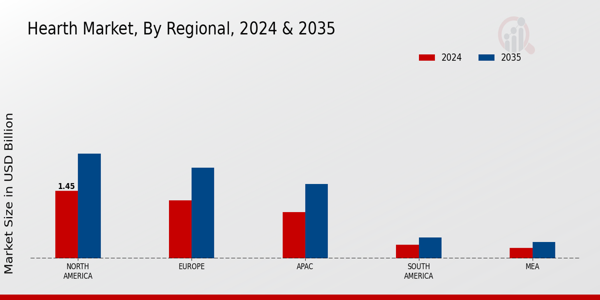Market Trends and Projections
The Global Hearth Market Industry is poised for substantial growth, with projections indicating a market size of 4.23 USD Billion in 2024 and an anticipated increase to 6.4 USD Billion by 2035. This growth trajectory suggests a compound annual growth rate of 3.84% from 2025 to 2035. Key drivers include rising demand for energy efficiency, technological advancements, and regulatory support for clean heating solutions. Additionally, the expansion of the construction and real estate sector further fuels this growth. As these trends continue to evolve, the industry is likely to adapt, presenting new opportunities for innovation and market expansion.
Rising Demand for Energy Efficiency
The Global Hearth Market Industry experiences a notable increase in demand for energy-efficient heating solutions. Consumers are increasingly seeking products that not only provide warmth but also reduce energy consumption. This trend is driven by rising energy costs and growing environmental concerns. As a result, manufacturers are innovating to create hearth products that meet these efficiency standards. The market is projected to reach 4.23 USD Billion in 2024, reflecting a shift towards sustainable heating options. This demand for energy efficiency is likely to propel the industry forward, as consumers prioritize both comfort and sustainability in their purchasing decisions.
Growing Preference for Aesthetic Appeal
Aesthetic appeal is increasingly influencing consumer choices within the Global Hearth Market Industry. Homeowners are recognizing the value of hearth products as focal points in interior design, leading to a surge in demand for stylish and customizable options. Manufacturers are responding by offering a diverse range of designs, materials, and finishes that cater to various tastes and preferences. This trend is particularly evident in urban areas where space is limited, and homeowners seek multifunctional products that enhance both aesthetics and functionality. As the market evolves, this focus on design is likely to drive growth, aligning with the overall trend of home improvement and renovation.
Technological Advancements in Hearth Products
Technological advancements play a crucial role in shaping the Global Hearth Market Industry. Innovations such as smart thermostats, remote control features, and improved combustion technologies enhance the functionality and appeal of hearth products. These advancements not only improve user experience but also contribute to better energy efficiency and lower emissions. As consumers become more tech-savvy, the demand for high-tech hearth solutions is expected to rise. This trend is likely to contribute to the market's growth, with projections indicating a market size of 6.4 USD Billion by 2035, as manufacturers continue to integrate cutting-edge technology into their offerings.
Regulatory Support for Clean Heating Solutions
Regulatory support for clean heating solutions significantly impacts the Global Hearth Market Industry. Governments worldwide are implementing stricter emissions standards and promoting the use of renewable energy sources. This regulatory environment encourages manufacturers to develop hearth products that comply with these standards, fostering innovation and sustainability. As consumers become more aware of environmental issues, the demand for clean heating solutions is likely to increase. This shift is expected to contribute to a compound annual growth rate of 3.84% from 2025 to 2035, as the industry adapts to meet evolving regulatory requirements and consumer preferences.
Expansion of the Construction and Real Estate Sector
The expansion of the construction and real estate sector is a significant driver for the Global Hearth Market Industry. As new residential and commercial properties are developed, the demand for hearth products is expected to rise. This trend is particularly pronounced in emerging markets where urbanization is accelerating. Builders and developers are increasingly incorporating hearth solutions into their designs to enhance property value and appeal. This growth in construction activity is likely to create new opportunities for manufacturers, contributing to the overall market expansion. The anticipated growth in the sector aligns with the broader trends of home improvement and energy-efficient building practices.
























